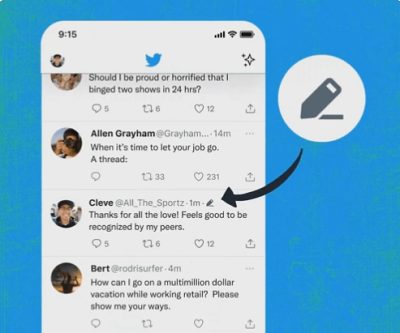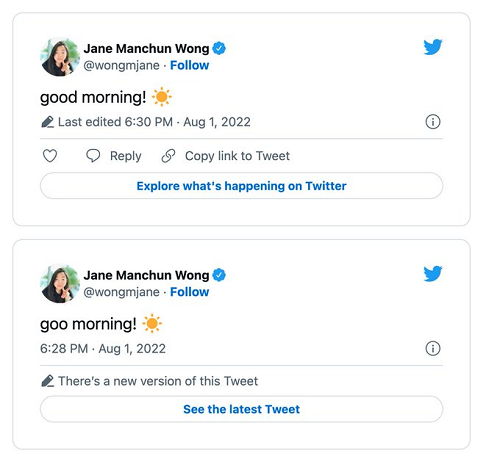It’s happening.
After years of requests, via millions of tweets, Twitter has finally launched the first stage of the roll-out of its new tweet editing feature, with Twitter Blue subscribers in Canada, Australia and New Zealand now able to revise their tweeted content for 30 minutes after posting.
As you can see in this sequence, the process is fairly straightforward. Now, after you’ve posted your tweet, you’ll see a notification informing you that you can make changes within the next half hour. Users can make up to five edits to the original tweet within that period.
To edit a tweet, you’ll tap on the three dots menu at the top right of the tweet. You’ll then select ‘Edit Tweet’ and make the required changes.
Edited tweets will then see a new ‘Edited’ icon added to them in-stream, so that all users know that the original tweet has been changed.

Users will also be able to view the full edit history by tapping on the ‘Last edited’ indicator in the tweet detail screen (i.e. the expanded tweet display that you can access by tapping on a tweet).
It’s the first live launch of the feature to the public, after Twitter announced that it was building a tweet editing option back in April. That came after Elon Musk effectively let the cat out of the bag by using his new status as Twitter’s top shareholder to brag about how he could make tweet editing a reality. His public statements then forced Twitter to confirm that it had been working on an Edit button for some time.
In retrospect, it was the first sign of what the relationship between Musk and Twitter would become.
Twitter had long resisted adding an edit option due to the brief nature of tweets, which led to concerns that even the slightest of changes could significantly alter the context of the original message. That, in turn, could cause problems for tweets that people had retweeted, or tweet embeds on other sites.
The answer to the first element is the full edit history, which enables all users to glean context as to why it was originally shared – so when a celebrity inevitably re-tweets something that’s been edited into an offensive comment, they can now refer to the history to explain themselves.
On the second concern, Twitter’s also working on new notes to add to embedded tweets which will provide more context as to its edit history.

So you’ll theoretically be able to embed the original tweet in perpetuity, but readers will have the option to tap through to find out what the latest edits to that comment may be.
With the launch of public tweet editing, Twitter has also confirmed that tweet metadata is being made available on the Twitter API, providing developers with access to tweet editing and update history info.
Overall, it seems like a good solution – which it probably should, given that Twitter has been working on it for the better part of a year (or more). It also feels, and has felt like, Twitter’s concerns around tweet misinterpretation due to editing have been overblown, not because people won’t edit their retweeted tweets, but because it’s unlikely to become a major issue.
I mean, most other platforms have offered editing and embedding options for years, and it’s been fine. Tweets are shorter, but the likelihood of this becoming a widespread problem don’t seem to be a lot higher in this respect.
Either way, Twitter’s solutions seem to address the core concerns, and it’ll be interesting to see how Twitter Blue subscribers use the option, and whether we see a lot more edit icons appearing in tweet streams.
It’ll also be interesting to see if more people end up signing up for Twitter Blue as a result. Twitter upped the price of its subscription service back in July, seemingly in anticipation of its edit option being made available, with the much-requested feature potentially acting as a bigger lure to get more people paying to tweet.
I suspect that’ll happen, as people get excited about the option – though whether they then remain on board as permanent Blue members is another question entirely.
But maybe, if Twitter can get them to sign-up, that’ll be another important step to help maximize its direct monetization process.



